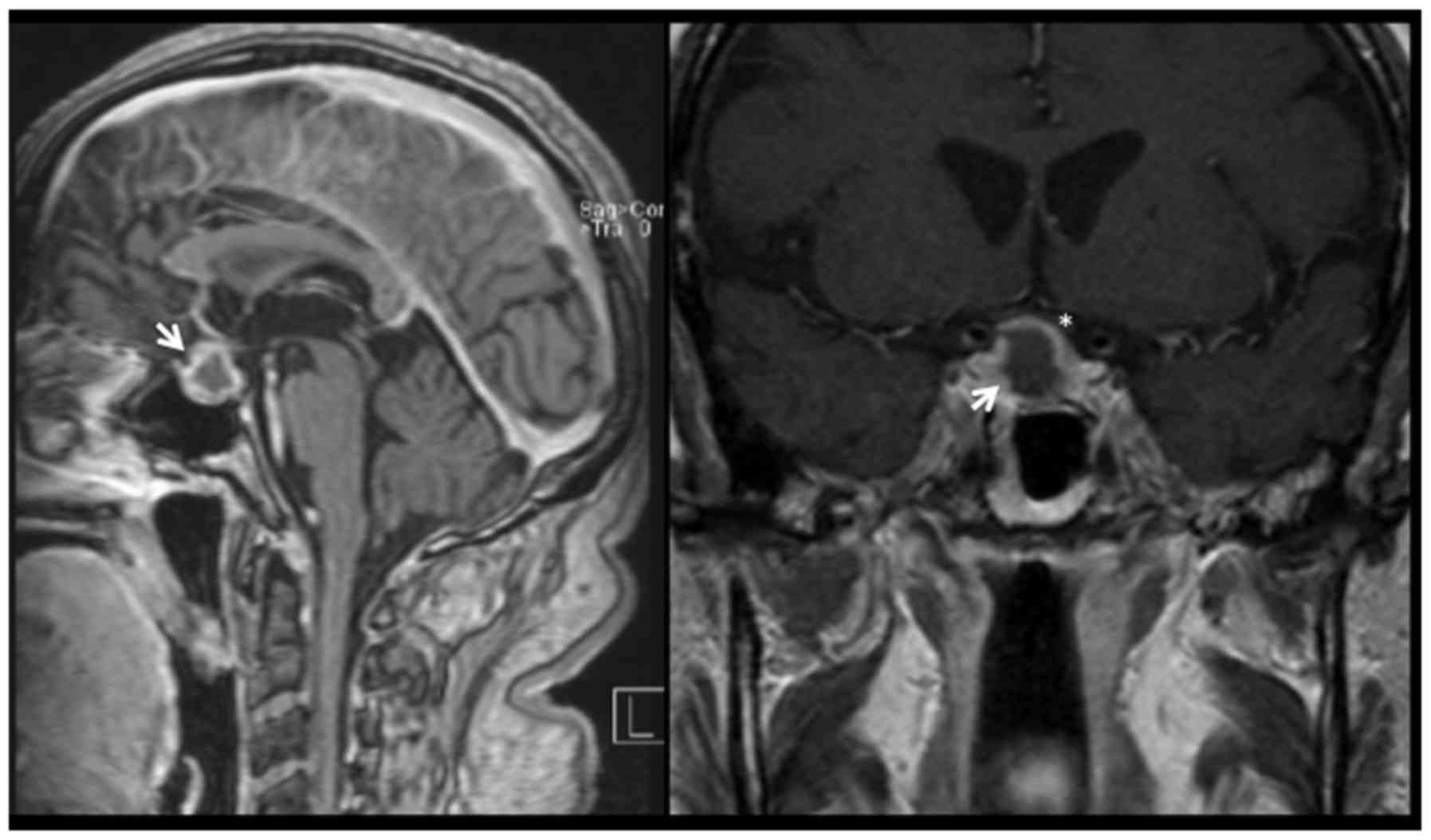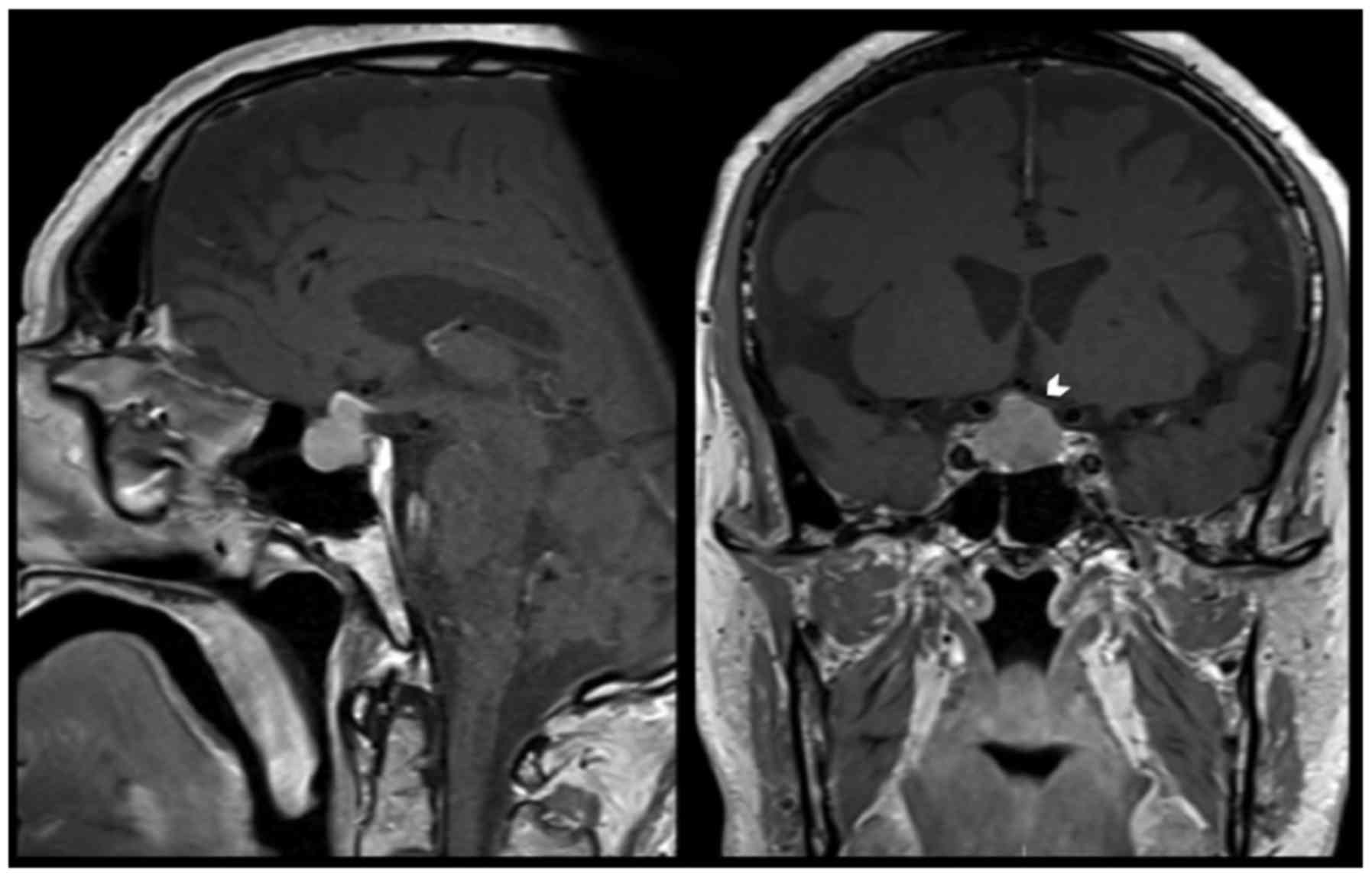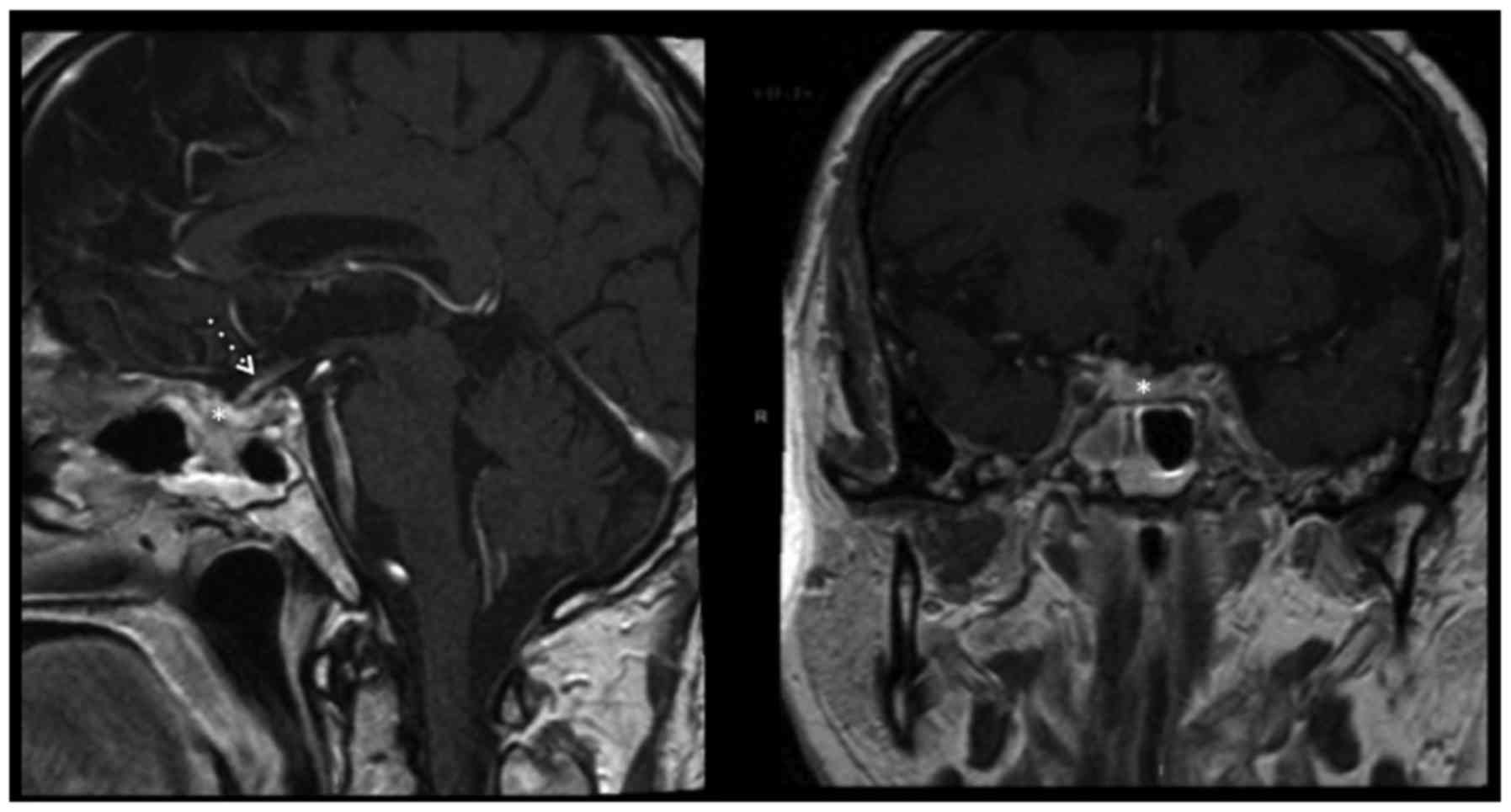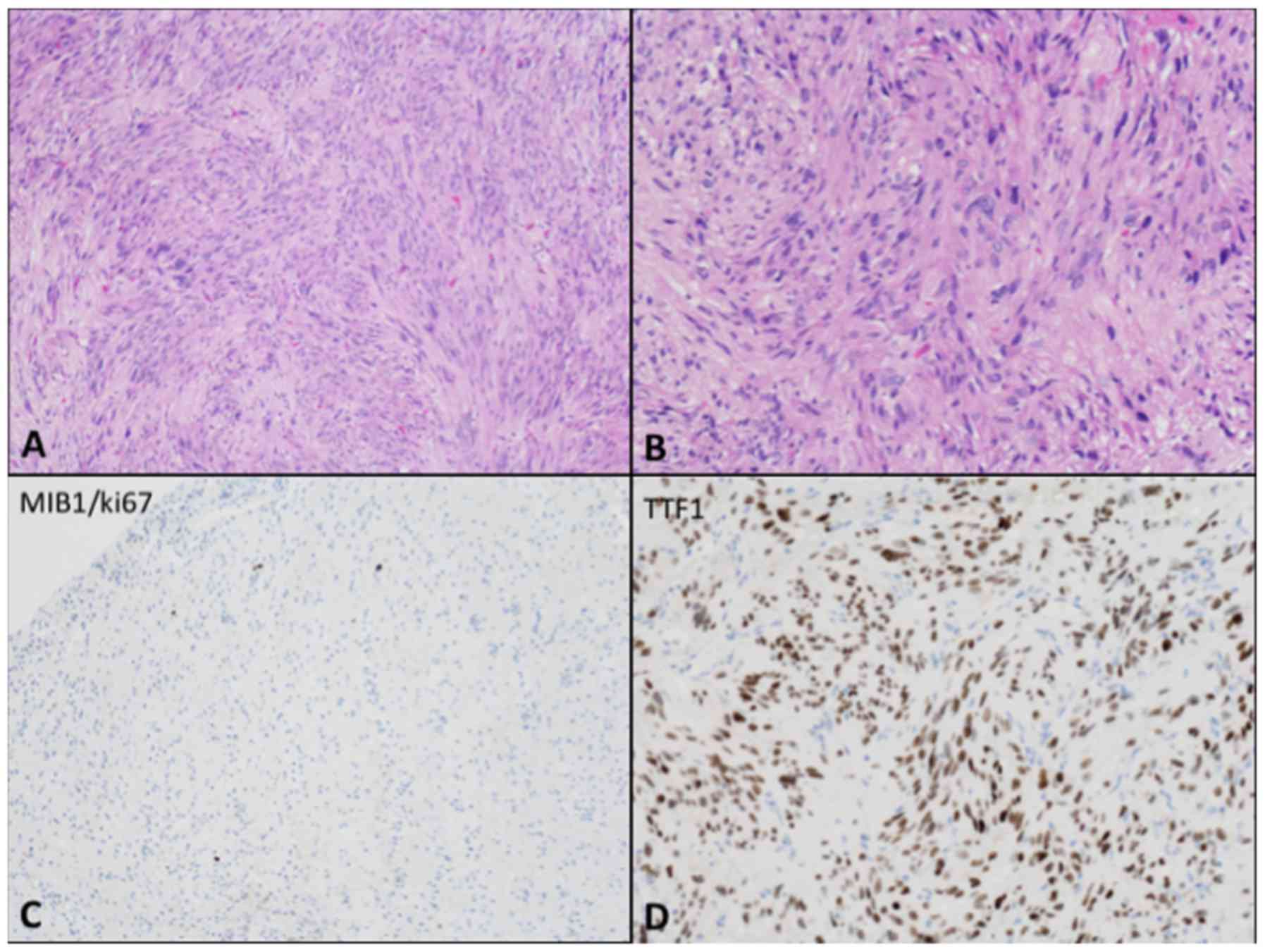An exceptional presentation of pituicytoma apoplexy: A case report
- Authors:
- Published online on: May 3, 2018 https://doi.org/10.3892/ol.2018.8625
- Pages: 643-647
Abstract
Introduction
Pituicytomas are rare slow-growing tumours arising from the glial cells of the neurohypophysis and infundibulum (pituicytes). The histogenesis, natural history and prognosis of these lesions still need to be elucidated, as data in the current literature remain scarce.
Since the first reported case in 1955 (1), there has been a surge in the number of case reports and small case series describing this rare entity. There are no gender-specific differences in the incidence of pituicytomas, and the average age of presentation is 50 years of age (2). No specific risk factors were identified. These neoplasms generally present with headaches, visual disturbances and manifestations of hypopituitarism (typically sexual dysfunction). The clinical presentation is almost identical to other more frequent sellar lesions, therefore correctly diagnosing these lesions can be challenging. Of about 80 cases described in the literature up until now (3), only one previous case reported an abrupt onset of clinical features and this was due to an intraventricular haemorrhage (4).
On imaging, even if pituicytomas present with suspicious radiological peculiarities, their rarity often leads them to be misdiagnosed for more common lesions. Surgical resection represents the mainstay of treatment, and this is typically via an endoscopic endonasal approach (5). However, complete resection may be challenging due to the firm consistency and highly vascularised nature of these tumours.
We report a novel case of a pituicytoma presenting as pituitary apoplexy, with the aim to advance a hypothesis to explain this phenomenon. To our knowledge this is the first reported case in the literature that describes the development of pituitary apoplexy in the context of a pituicytoma.
Case report
A 77-year-old man presented to the University Hospital of Lausanne in October 2015 with fatigue and clinical signs of hypogonadism. The clinical presentation was suggestive of hypopituitarism and endocrine tests showed an anterior pituitary dysfunction. Investigation with cerebral magnetic resonance imaging (MRI) demonstrated a sellar lesion with suprasellar extension and no compression of optic structures. He was admitted at the neurosurgical department and initial management consisted of hormonal replacement therapy and a ‘watch-and-wait’ approach. One year after his initial presentation (October 2016), the patient returned to the emergency department with a thunderclap headache. A cerebral MRI demonstrated pituitary apoplexy (Fig. 1). There were no visual deficits on clinical examination and we decided to continue the regular monitoring and follow-up. Over 6 weeks of follow-up the patient started complaining of visual symptoms, secondary to a progressive growth of the pituitary lesion with compression of the optic chiasm (Fig. 2). Ophthalmological examination confirmed a right temporal quadrantanopia.
The patient underwent an uncomplicated endoscopic endonasal transsphenoidal resection of the tumour. Post-operatively the patient recovered well, with the right temporal quadrantanopia completely resolving. Endocrine function remained impaired, with a persistent anterior hypopituitarism but no diabetes insipidus. A post-operative MRI confirmed complete excision of the lesion (Fig. 3), and follow-up imaging at 15 months confirmed that the patient was still in remission.
The diagnosis of a pituicytoma was confirmed by pathologic examination and immunohistochemistry performed on four-micron thick, formalin fixed and paraffin embedded sections, analysed with a Nikon Eclipse microscope and a Nikon DSFi1 camera (both from Nikon Corporation, Tokyo, Japan). Spindle-shaped cells with a fascicular growth pattern and heterogeneous nuclei were identified with hematoxylin and eosin stain (Fig. 4A and B). There was no evidence of atypical cellular features or mitotic figures and the detection of proliferation markers was performed on paraffin sections with anti-Ki67 (MIB-1; Immunotech; Beckman Coulter, Inc., Brea, CA, USA) with the cell count performed at high power (×400). Cellular proliferation resulted inferior to 1% (Fig. 4C). Immunohistochemical staining was performed through the Ventana platform and it revealed tumour cells positive for thyroid transcription factor-1 (TTF-1) (Fig. 4D), S-100, vimentin, B-cell lymphoma 2 (Bcl-2) and CD56. The cells were negative for synaptophysin, glial fibrillary acidic protein (GFAP), epithelial membrane antigen (EMA), signal transducer and activator of transcription (STAT)6, cluster of differentiation 34 (CD34), Melan-A, human melanoma black 45 (HMB45), (tumor) protein 63 (P63), calretinin and neurofilament (NF). The details for each antibody and for the methodology used to perform immunohistochemistry were reported in Table I. The entire sections on the stained slides were evaluated. Electron microscopy was not performed.
Discussion
Pituicytomas are defined as indolent World Health Organization (WHO) grade 1 tumours involving the posterior lobe of the pituitary and/or the pituitary stalk. They are solid tumours, generally well circumscribed and composed of spindle cells derived from pituicytes (6,7).
Pituicytomas are slow growing and they may often go unnoticed until clinical signs and symptoms secondary to mass effect start to develop. These lesions are known to compress the pituitary gland and the optic system, thus provoking more frequently hypopituitarism and visual disturbance. We describe here the first reported case of pituitary apoplexy secondary to a pituicytoma. The primary goal of the management was to mitigate the consequences of apoplexy through urgent hormonal substitution and to monitor for visual deficits. Surgical management was decided upon following the development of a visual deficit.
Pituicytomas have similar radiological features to pituitary adenomas, thus distinguishing these diagnoses from one another based on radiological imaging remains challenging. They are often described as sellar lesions with frequent suprasellar extension and sellar enlargement (and/or bone remodelling). They generally present as isointense lesions on T1-weighted MRI and the posterior lobe of the pituitary gland is generally not identifiable, while they appear as hyperintense lesions on T2-weighted images (2,8). T1-weighted MRI sequences with gadolinium contrast enhancement may prove useful in diagnosis, as pituicytomas may appear brighter than classical adenomas due to their dense vascularisation (4). A recent paper reports the usefulness of flow voids at the MRI to differentiate pituicytomas from pituitary adenomas. Flow voids represent signal loss due to rapidly flowing blood, and thus indirectly equate to increased vascularity (9). Angiography may also be a useful tool, with a vascular blush typical of pituicytomas (2). Despite these differences, radiological distinction from other more common sellar lesions, such as pituitary adenomas and meningiomas, is not always easy.
Considering this, the diagnosis of a pituicytoma strongly relies on pathological analysis and immunohistochemical investigations, as pituicytomas demonstrate a characteristic immunohistochemical profile with a strong positive staining for S-100 and TTF-1, a focal positivity for GFAP, and an absence of staining for synaptophysin, p53 or pericellular reticulin (6,10,11).
The mainstay of treatment for symptomatic pituicytomas is surgery, with gross total resection considered curative. Unfortunately, due to the dense vascularity and the firm consistency of these tumours, the extent of resection is often limited. Precise surgical planning is necessary, with a focus on the extension of the tumour itself and its radiological characteristics. The development of endoscopic surgery has led to an endonasal approach being the preferred procedure.
Our case had a peculiar clinical presentation and we suggest that apoplexy was most likely due to the haemorrhagic transformation or to the intralesional ischemia secondary to the rupture or the occlusion of pathological vessels arising directly from the internal carotid artery or from its branches. We put forth the hypothesis that the incidence of pituicytoma apoplexy might actually be underestimated, as with pituitary apoplexy, surgery and tissue diagnosis is performed only in cases complicated by visual disturbance.
We assert that pathologists, endocrinologists and neurosurgeons should be mindful of pituicytoma as a possible differential diagnosis when dealing with pituitary apoplexy.
Recommendations and future directions
Over the last few years there has been substantial advancement regarding the definition and classification of pituicytomas (7). However, the histogenesis of these lesions remains controversial, and the natural history of progression of this disease is yet to be elucidated. Understanding the natural history of these tumours is difficult, because all of the cases described so far have been diagnosed retrospectively following surgical management and pathological confirmation.
Treatment is mainly empirical, and when gross total resection is possible, management is relatively straightforward. In cases where only subtotal resection is possible, the use of adjuvant therapies is highly debated, and there is no existing evidence to recommend specific management.
Further work to clarify the optimal management of patients with pituicytomas still needs to be undertaken, and we hope that future studies will help to standardise treatment strategies.
To conclude, pituicytomas are rare and indolent lesions. However, atypical presentations may be challenging and should not be underestimated. Due to the vascularised nature of these lesions, haemorrhagic or ischaemic events are potential serious consequences. We assert that a wider range of differential diagnoses should be considered when clinicians encounter pituitary apoplexy in the context of hypervascularised pituitary lesions not associated with abnormal hormonal secretion.
Acknowledgments
We would like to thank Mr. Michael Nohrenberg from the Medical University of Melbourne for his help with revising the English of the article.
Funding
No funding was received.
Availability of data and materials
All data generated or analyzed during this study are included in this published article.
Authors' contributions
GC, JD, RTD and MM contributed to the design and conception of the study. GC and JD proceeded with the acquisition of data, GC performed a literature review and JPB performed the pathological analysis and provided the necessary material. All the authors contributed substantially to the drafting of the manuscript and revised it critically for important intellectual content. They all gave final approval of the version to be published.
Ethics approval and consent to participate
Informed consent was obtained from the patient.
Consent for publicationv
The patient has consented to the submission of this case report for publication.
Competing interests
The authors declare that they have no competing interests.
References
|
Scothorne CM: A glioma of the posterior lobe of the pituitary gland. J Pathol Bacteriol. 69:109–112. 1955. View Article : Google Scholar : PubMed/NCBI | |
|
Wolfe SQ, Bruce J and Morcos JJ: Pituicytoma: Case report. Neurosurgery. 63:E173–E174; discussion E174. 2008. View Article : Google Scholar : PubMed/NCBI | |
|
Yang X, Liu X, Li W and Chen D: Pituicytoma: A report of three cases and literature review. Oncol Lett. 12:3417–3422. 2016. View Article : Google Scholar : PubMed/NCBI | |
|
Benveniste RJ, Purohit D and Byun H: Pituicytoma presenting with spontaneous hemorrhage. Pituitary. 9:53–58. 2006. View Article : Google Scholar : PubMed/NCBI | |
|
Messerer M, De Battista JC, Raverot G, Kassis S, Dubourg J, Lapras V, Trouillas J, Perrin G and Jouanneau E: Evidence of improved surgical outcome following endoscopy for nonfunctioning pituitary adenoma removal. Neurosurg Focus. 30:E112011. View Article : Google Scholar : PubMed/NCBI | |
|
Brat DJ, Scheithauer BW, Fuller GN and Tihan T: Newly codified glial neoplasms of the 2007 WHO classification of tumours of the central nervous system: Angiocentric glioma, pilomyxoid astrocytoma and pituicytoma. Brain Pathol. 17:319–324. 2007. View Article : Google Scholar : PubMed/NCBI | |
|
Mete O and Lopes MB: Overview of the 2017 WHO classification of pituitary tumors. Endocr Pathol. 28:228–243. 2017. View Article : Google Scholar : PubMed/NCBI | |
|
Hurley TR, D'Angelo CM, Clasen RA, Wilkinson SB and Passavoy RD: Magnetic resonance imaging and pathological analysis of a pituicytoma: Case report. Neurosurgery. 35:314–317; discussion 317. 1994. View Article : Google Scholar : PubMed/NCBI | |
|
Law-Ye B, Cholet C and Leclercq D: First depiction of flow voids to differentiate pituicytomas from giant adenomas. World Neurosurg. 109:304–306. 2018. View Article : Google Scholar : PubMed/NCBI | |
|
Figarella-Branger D, Dufour H, Fernandez C, Bouvier-Labit C, Grisoli F and Pellissier JF: Pituicytomas, a mis-diagnosed benign tumor of the neurohypophysis: Report of three cases. Acta Neuropathol. 104:313–319. 2002.PubMed/NCBI | |
|
Ulm AJ, Yachnis AT, Brat DJ and Rhoton AL Jr: Pituicytoma: Report of two cases and clues regarding histogenesis. Neurosurgery. 54:753–757; discussion 757–758. 2004. View Article : Google Scholar : PubMed/NCBI |













